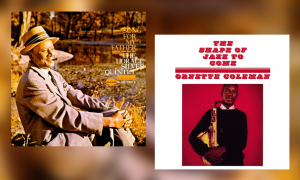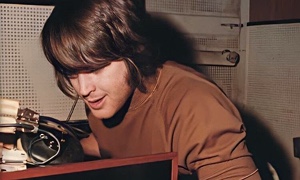Home » Jazz Articles » Building a Jazz Library » Wayne Shorter: An Essential Top Ten Albums
Wayne Shorter: An Essential Top Ten Albums

Courtesy Daniel Sheehan
With hindsight, a fitting nickname for Shorter would be The Mysterious Traveller, after the piece he wrote for Weather Report. It references his search for self-awareness and cosmic truth, his love of superhero comics and, above all, the vibe of idiosyncrasy going on outright otherness that permeates his music.
Anyway, there it is. Absence is dedicated to Shorter for "being brilliant" and one cannot argue with that. Shorter has been shining a light as a soloist and as a composer and arranger since the late 1950s under his own name and as a featured sideman; Art Blakey's The Jazz Messengers (1959—1964), Miles Davis' second great quintet (1965—1968) and Weather Report (1971-1985) are among the latter highlights.
Given his long stints as a sideman, and considering he released his first own-name album in 1960, there is some justification in calling Shorter a reluctant bandleader. A more accurate description, however, would be a genius musician with his ego firmly under control. This is a result, in part, of Shorter's many years practicing Japanese Nichiren Buddhism. A key Buddhist tenet is the idea of life being a learning curve. A Buddhist is a perpetual student until enlightment is reached.
So, for twenty-five years after releasing his first album, and for twenty years after releasing his first universally acknowledged masterpiece, Shorter was happy to spend most of his professional life working under leaders who he felt could teach him something, releasing his own albums almost on the side. "I had the most fun playing with Miles Davis," Shorter told interviewer Bob Blumenthal in 2002. "John Coltrane told me that too. Now the same kind of fun is happening with John Patitucci and Brian Blade and Danilo Pérez. Over the years I had fun playing with Joe Zawinul and Herbie Hancock. But Miles was a 'source' kind of guy. You know how Captain Marvel would go to Delphi, to get his shazam stuff together? Miles was like that [for me]."
With hindsight, rather than Mr Gone or Mr Weird, a fitting nickname for Shorter would be The Mysterious Traveller, after the piece he wrote for Weather Report. It references his search for self-awareness and cosmic truth, his lifelong love of superhero comics and, above all, the vibe of idiosyncrasy going on outright otherness that has permeated his music since Night Dreamer (Blue Note, 1964).
Shorter's first purple period under his own name—unlike most musicians, he has enjoyed two such periods, with the second still in full bloom in 2021—was in the mid and late 1960s on Blue Note. Any one of the eleven albums he recorded for the label between 1964 and 1970 could be included in this Top Ten. Just five are included below, so as to make room for the second belle epoque. This began in 2000 when, after an all-consuming time with Weather Report and a generally underwhelming own-name tenure with Columbia, Shorter formed his current quartet with Perez, Patitucci and Blade. On Verve, he hit new creative peaks which continued, and indeed have escalated, since he returned to Blue Note in 2009.
Shorter is well known for his gnomic comments and a disinterest in talking about the mechanics of music making. But some of his pronouncements are as clear as you could wish. One such is, "To hell with the rules, I'm going for the unknown." Another is, "Jazz shouldn't have any mandates. Jazz is not supposed to be something that's required to sound like jazz. For me, the word 'jazz' means, 'I dare you.'"
Shorter's most resonant sound bite, however, may be something he said to Blumenthal in 2002. "I'm ready to kick ass," said Shorter. "I'm going to be seventy in August 2004 and it feels like [adopting a conspiratorial voice] there's a red door down there, waiting for me. But before I go through that door, I'm going to go to the end of the line and stick with what I'm doing."
Shorter has been as good as his word, and he is not done yet. Although currently not performing, he is understood to have written a jazz-meets-classical opera in collaboration with bassist Esperanza Spalding, which is already in the can and due for release in late 2021 or early 2022. He may temporarily be "absent," but only from the stage.
Wayne Shorter: An Essential Top Ten Albums
This list purposely excludes any of Shorter's albums with Art Blakey, Miles Davis or Weather Report, from which at least two more Essential Top Tens could be selected. Unless indicated otherwise, all cited tracks were written by Shorter. Wayne Shorter
Wayne Shorter Introducing Wayne Shorter
Vee Jay, 1960
It is always worth having the debut album by a favourite artist on your shelves. Little acorns, hear them grow. There are, in fact, two not-so-little acorns here, in the form of Shorter and his soon-to-be fellow Jazz Messenger, trumpeter Lee Morgan. Introducing was recorded in late 1959 with a group completed by some of the players who a few months earlier had contributed to Miles Davis' masterpiece Kind Of Blue (Columbia). Pianist Wynton Kelly, bassist Paul Chambers and drummer Jimmy Cobb deliver deep pocket accompaniment on five Shorter originals and a molten reading of Kurt Weill's "Mack The Knife." Morgan is already his own man. Like practically every other tenor saxophonist of his generation, Shorter was profoundly influenced by Coltrane, seven years his senior; that comes through on Introducing, not least in Shorter's tone, but there are clear glimpses of the singularity to come.
 Wayne Shorter
Wayne Shorter Night Dreamer
Blue Note, 1964
Five years and two Vee Jay albums on, Shorter makes his Blue Note debut and his first major statement. Morgan is back, joined by three past or current members of John Coltrane's quartet: pianist McCoy Tyner, bassist Reggie Workman and drummer Elvin Jones. Recorded in April 1964, the same month that Coltrane recorded Crescent (Impulse), the narrative arc of Night Dreamer resonates with Coltrane's album, and to a lesser extent with A Love Supreme (Impulse, 1965). But the differences are marked. As a player, Shorter spends more time in the middle and lower registers and blows one note for every three or four of Coltrane's. As a thinker, his world view, as expressed in the liner notes and laid out in the suite-like structure of the album, is metaphysical rather than religious or even spiritual; and after Shorter adopted Buddhism, he continued to wear humanity on his sleeve, not God. In 2021, he still does. Jones is a perfect, listening partner. Whereas Blakey liked his soloists to play every chorus as though it was the climax of the Super Bowl, Jones allows Shorter to build intensity at his own pace. A beautiful album, from the exultant "Black Nile" and "Charcoal Blues," through the lovely ballad "Virgo" and on to the minor-keyed post-hard boppers "Night Dreamer" and "Armageddon."
JuJu (Blue Note, 1965), recorded two months after Night Dreamer, with the same lineup minus Morgan, is just as good.
 Wayne Shorter
Wayne Shorter Speak No Evil
Blue Note, 1966
A 360-degree masterpiece, Speak No Evil is one of the top half dozen Blue Note albums of the era. The disc was recorded in December 1964, not long after Shorter had joined Miles Davis. In the eight months following Night Dreamer, Shorter's tone has shed most of its Coltrane echoes; it is no less robust but has taken on a distinctive, velvety quality. The lineup includes two colleagues from Davis' group, pianist Herbie Hancock and bassist Ron Carter. Elvin Jones remains on drums. The addition of trumpeter Freddie Hubbard makes the new lineup a quintet and his expansive presence precludes any danger of it resembling one led by Davis. The empathic Hancock has remained close to Shorter ever since. The pair can be seen and heard playing in close harmony, in every sense, in the 2018 documentary Blue Note Records: Beyond The Notes, on a reimagining of Shorter's "Masqualero, which they first recorded on Davis' Sorcerer (Columbia, 1967). The track is included on the Robert Glasper-led Blue Note All-Stars' album Our Point Of View (Blue Note, 2017).
Compositionally, Shorter reached a new peak on Speak No Evil. "Witch Hunt," "Fee-Fi-Fo-Fum," "Dance Cadaverous," "Speak No Evil" and "Infant Eyes" are simply sublime. Davis, looking for an inhouse composer, recruited Shorter at precisely the right moment.
 Wayne Shorter
Wayne Shorter The All Seeing Eye
Blue Note, 1966
As with Night Dreamer, Shorter's concept for The All Seeing Eye, his second virtual suite, has a Venn diagram relationship to John Coltrane's contemporaneous inspirations. Recorded in autumn 1965, eight months after A Love Supreme was released, Shorter's album is a darker affair on which he fronts his largest ensemble, and writes his most turbulent arrangements, to date. Three other horns complete the frontline—Freddie Hubbard (trumpet and flugelhorn), Grachan Moncur (trombone) and James Spaulding (alto saxophone)—with Hancock, Carter and drummer Joe Chambers stoking the fire. The opening title track evokes an all-powerful Creator bringing about the solar system, an explosive process. "Genesis" concerns the beginning of life on Earth. "Chaos" is about the mess humankind, when acting at its worst, can make of the planet. The closing "Face Of The Deep" has the Creator reflecting on all this. A fifth track, "Mephistopheles," written by Shorter's brother, Alan Shorter, who is featured on flugelhorn, takes us to the gates of Mordor. Yes, in the parlance of the time, this was heavy shit. The general vibe, however, is one of hope.
 Wayne Shorter
Wayne Shorter Adam's Apple
Blue Note, 1966
A relatively easy-going affair, Adam's Apple is the yin to The All Seeing Eye's yang. The band is a quartet, completed by Herbie Hancock, Reggie Workman and Joe Chambers. Shorter has never been a bar-walking tenor player, but he gets close on the opening title track, which parallels Lee Morgan's hit "The Sidewinder." Hancock can get as funky as you like—as he demonstrated on guitarist Grant Green's gospel infused Feelin' The Spirit (Blue Note, 1963)—and he locks tight into Shorter's groove. In a complete change of mood, the track is followed by Jimmy Rowles' lovely ballad "502 Blues (Drinkin' And Drivin')," the only tune not written by Shorter. The samba-esque "El Gaucho" follows, and then the debut of Shorter's first contribution to the jazz standards book, the glorious "Footprints." A second ballad, "Teru," precedes the closer, "Chief Crazy Horse," the album's nod to intensity.
 Wayne Shorter
Wayne Shorter Super Nova
Blue Note, 1969
At this point, things get pretty tangled up with Miles Davis. Three of Shorter's pieces on Super Nova, his first journey into fusion under his own name, were originally recorded by Davis, with Shorter, in summer 1967, but were shelved until 1976, when they became side one of the Davis LP Water Babies (Columbia). The three tunes are "Water Babies," "Capricorn" and "Sweet Pea." Fast forward to autumn 1969 and the sessions for Super Nova. By now, Shorter was wondering whether the Davis recordings would ever get released, so he rerecorded all three pieces for his own album. The personnel is electric-Davisian going on Weather Reportish. It includes John McLaughlin and Sonny Sharrock on guitar, Chick Corea on drums and vibraphone, Jack DeJohnette on drums, Miroslav Vitous on bass and Airto Moreira on percussion. Shorter himself plays soprano (his first outing on the instrument in this Top Ten). There is fusion and there is fusion, and Super Nova, like Davis' Bitches Brew (Columbia, 1970), has nothing to do with the bland dreck with which the genre later became synonymous. This is adventurous, uncompromising jazz.
 Wayne Shorter
Wayne Shorter Alegria
Verve, 2003
In 2000, Shorter announced his bounce back from the Columbia years with the formation of what has proved to be a long-lasting acoustic quartet with pianist Danilo Perez, bassist John Patitucci and drummer Brian Blade. Footprints Live! (Verve, 2002), recorded on tour in 2001, remains a great calling card. But Alegria, on which the quartet is augmented, but never overwhelmed, by woodwind, brass and string ensembles, has all the grace and grit one could hope for in Shorter's first acoustic studio album in almost thirty-five years. The approachable sophistication of Shorter's arrangements, which were wasted on Marcus Miller's pimped-up production of High Life (Verve, 1995), is a thing of wonder. There are some old favourites, sumptuously recostumed—"Angola," "Orbits," "Capricorn ll"—a striking new original, "Sacajawea," which opens the disc, and five pieces by other composers which it would be an insult to call covers, among them Villa-Lobos' "Bachianas Brasileiras," reimagined for the quartet and seven cellos.
 Wayne Shorter Quartet
Wayne Shorter Quartet Beyond The Sound Barrier
Verve, 2005
Recorded live on tour by the quartet between 2002 and 2004, Beyond The Sound Barrier is the companion piece to Footprints Live! . It differs from, and is arguably more impressive than, the earlier album in two respects. In 2001 the emphasis was on evergreens from Shorter's back catalogue, "Footprints," "Valse Triste," "Masqualero" and "Sanctuary" among them. On the 2002 -2004 tours, new originals are included. Perhaps more importantly, Beyond The Sound Barrier chronicles the leap forward the quartet has taken as a unit during its still relatively brief existence. Every track is in essence a group improvisation; there is no sense of leader and rhythm section or lead and supporting instruments. The dynamic harks back, in a good way, to the Miles Davis quintet, featuring Shorter, which recorded Nefertiti (Columbia, 1968), where on "Nefertiti," and to a lesser extent on "Fall" and "Pinocchio," the conventional relationship between the instruments is reconfigured.
 Wayne Shorter Quartet
Wayne Shorter Quartet Without A Net
Blue Note, 2013
Recorded live in Europe in 2011, Without A Net has Shorter back where he (almost) began, on Blue Note, this time with a quartet which has been together for eleven years and yet has retained every ounce of its founding exploratory approach. Indeed, moving forward, each new album the group has released sounds more adventurous and in the moment than the one before. Six of the pieces are Shorter originals, and include another spin on the golden oldie "Orbits;" two more are group compositions; the ninth is a cover of Vincent Youmans' theme tune for the 1933 movie Flying Down To Rio, at just shy of thirteen minutes the second longest track on the album. The longest, at twenty-three minutes, is Shorter's "Pegasus," which was recorded in 2010 at the Walt Disney Concert Hall in Los Angeles, with the quartet augmented by the woodwind quintet Imani Winds. It is revisited in expanded form on what, at the time of writing in September 2021, is Shorter's latest album and which is, perhaps, his magnum opus....
 Wayne Shorter
Wayne Shorter Emanon
Blue Note, 2018
Emanon was originally released as a 3 CD box set which included a seventy-four-page graphic novel. Disc one, which comprises a four-movement, fifty-minute suite, was recorded in the studio in 2016 by the quartet augmented by the Orpheus Chamber Orchestra. Discs two and three were recorded by the quartet live in London, still sounding out there after all the years together. The graphic novel, a collaboration with DC Comics artist Randy DuBurke, is a companion artefact to disc one's suite and is the closest we have got to date to an exposition on paper of Shorter's take on the meaning of life. It tells the story of a superhero, Emanon (the reverse spelling of No Name), who takes on the bad guys and promotes truth and self-awareness. As noted above, 1966's The All Seeing Eye was heavy shit. Fifty years on, it gets heavier... and The Mysterious Traveller strides on.
Tags
PREVIOUS / NEXT
Support All About Jazz
 All About Jazz has been a pillar of jazz since 1995, championing it as an art form and, more importantly, supporting the musicians who make it. Our enduring commitment has made "AAJ" one of the most culturally important websites of its kind, read by hundreds of thousands of fans, musicians and industry figures every month.
All About Jazz has been a pillar of jazz since 1995, championing it as an art form and, more importantly, supporting the musicians who make it. Our enduring commitment has made "AAJ" one of the most culturally important websites of its kind, read by hundreds of thousands of fans, musicians and industry figures every month.





















